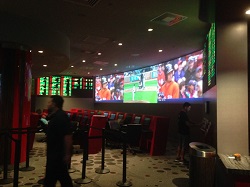Betting Strategy: How Much to Bet Per Game

Every passionate sports fan would love to bet on sports for a living. Only a small percentage actually do. Having the skill to win enough games to beat the house is obviously required. But simply beating the house isn’t going to guarantee you will earn enough to pay your bills, buy fancy cars, take those dream vacations, etc. You need to bet enough per unit so that your income is at the desired level. How do you determine how much per unit to wager? It’s a non-complicated task that I’m about to explain:
Establishing the break-even point
Before you start thinking about profits, we must first establish the break-even point when betting against the spread. Because the odds ATS are –110 (you bet $11 to win $10), to break even, you’ll need to win 52.4% of the time (524 out of 1,000 games). Winning 52.4% of your games ATS isn’t going to beat the house. You won’t lose any money, but the only things gained will be some free drinks. Great if you’re on vacation. Not so great if you’re trying to earn a living.
How far beyond the break-even point must you get?
This is where it gets a bit complicated. Now that we know we have to exceed a 52.4% win rate, we need to determine just how far beyond the break-even point we must get in order to earn a living. For this example, let’s assume the desired income is $50,000 per year. You can get to $50,000 by winning just 53% of your games, but you will have to bet massive amounts per game in order to get there. Your house edge is a mere 0.6% at 53%. If you bet $100 per game, you’ll need to win 500 games more than you lose. If you bet $1,000 per game, you’ll need to win 50 games more than you lose.
So determining how far beyond the break-even point is based on how much you’re willing to wager per game. $1,000 per game might not be feasible for you. Therefore, to make that $50,000, you’re likely going to have to get your win rate well above 53%. Either that or bet on about 5 games every day of the year. Getting to 60% is going to be difficult. It’s not impossible, but even the top sports bettors struggle to get to 60%. Sure, there are tons of sports betting services out there claiming they win even more than that. They’re full of it.
How to Improve Your Game
Earning a nice living betting on sports isn’t easy because there is minimal margin for error. The juice on a straight bet is a killer. If sportsbooks would lay even money on a straight bet, making big bucks betting on sports wouldn’t be that difficult. That extra 2.4% house edge makes it difficult to profit. That makes it essential to step your game up and get close to 60% on straight bets. Here are a few tips to help:
- Wager against teams the public is betting on heavily. Most of these teams are over-hyped and/or the lines become quite favorable to those betting on the underdog.
- Unless the spread is exactly where you want it to be at the beginning of the week, wait until late in the week to see how the general public wagers. You might find more favorable odds later in the week.
- Bet mostly on teams you are familiar with. There’s more to sports than statistics. You have an advantage over the general public if you are wagering on teams you frequently watch.
Bankroll Percentage
When asked about how much a person should bet the general consensus in the betting industry is that you shouldn’t wager more than 5% of your bankroll on a single wager. This will allow enough of a cushion to exist in case of a really nasty losing streak occurs. You will be able to bounce back.
Unit Betting
Using the bankroll percentage recommendations as a guide, assign units to the size of your wagers. One unit would equal 1% of your bankroll. If your bankroll is $20K then a 1 unit play would be a $200 wager. Under these same criteria you should never risk more than $1000 on a single wager.
Exceptions
If you have one game left that you really like and it is the last game of the season, ie., Super Bowl, NCAA Championship Game, and you have no plans to bet on other sports in the near future, you can plop down your winnings in a double-or-nothing scenario.
Example: A player has built a $5,000 account balance from a $1,000 deposit he made a few months ago. He has met the rollover requirements and really likes a team in the Super Bowl. He also has no plans to bet basketball which is in season at the same time. The player really can risk it all if he chooses to do so and not violate any real betting strategies. Personally I would suggest risking no more than half so that regardless of the outcome, you come away with something.
















